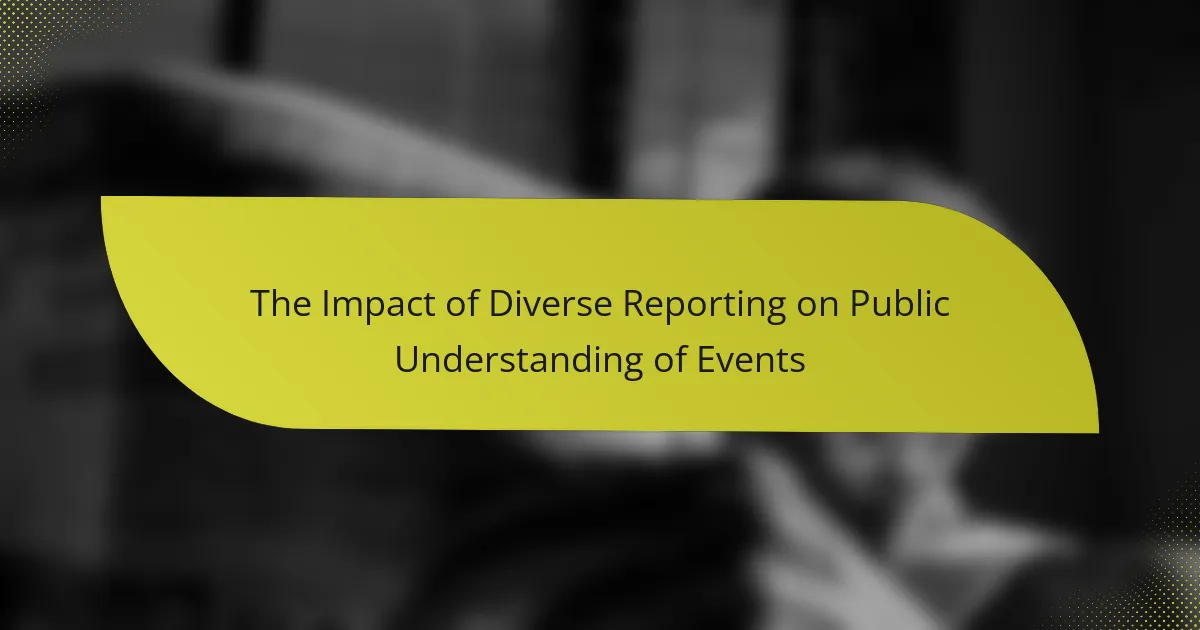Diverse reporting plays a crucial role in enhancing public understanding of events by offering multiple perspectives and interpretations. By presenting a variety of viewpoints, it allows individuals to develop a more nuanced understanding, encourages critical thinking, and reduces the risk of being influenced by singular narratives. This multifaceted approach not only improves the accuracy of information but also fosters greater engagement among audiences.
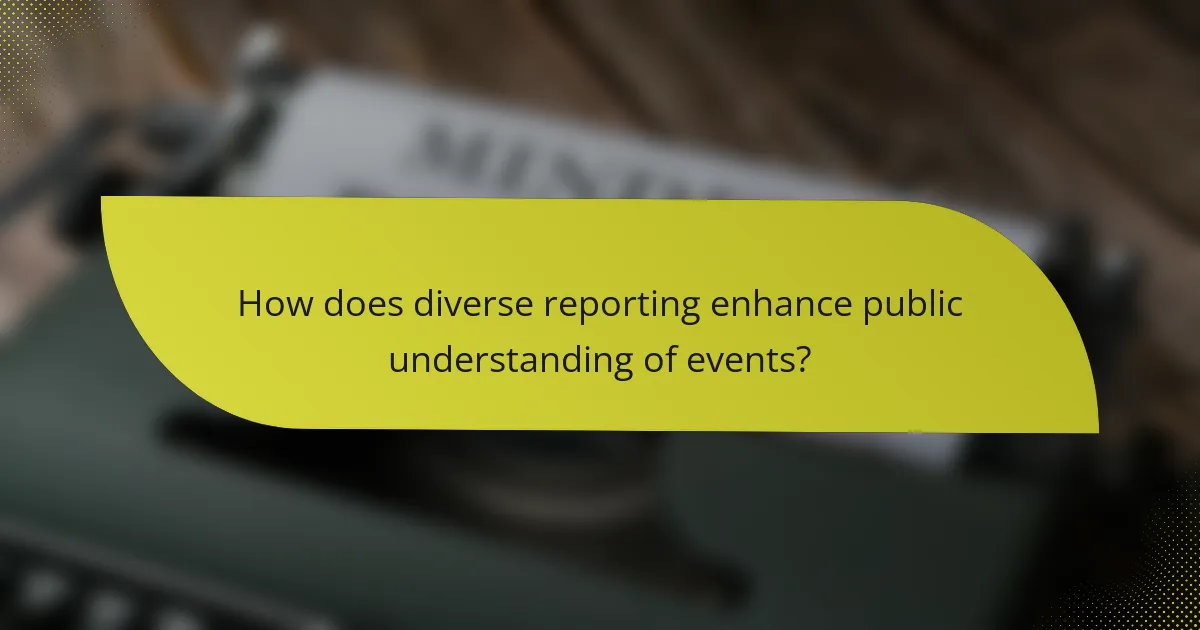
How does diverse reporting enhance public understanding of events?
Diverse reporting enhances public understanding by presenting multiple viewpoints and interpretations of events, allowing individuals to form a more comprehensive picture. This approach encourages critical thinking and helps mitigate the influence of singular narratives that may distort reality.
Increased perspectives
Diverse reporting brings together various perspectives from different sources, cultures, and communities. For instance, a news story about a political event may include viewpoints from local citizens, experts, and international commentators, enriching the narrative.
This multiplicity of voices allows audiences to see issues from different angles, fostering empathy and a deeper understanding of complex situations. Readers can better appreciate the nuances that a single perspective might overlook.
Broader context
By incorporating diverse reporting, media can provide broader context surrounding events. This includes historical, social, and economic factors that influence current happenings. For example, reporting on climate change might include scientific data, personal stories from affected communities, and insights from policymakers.
This context helps audiences connect the dots between events and their implications, leading to a more informed public. It encourages individuals to consider not just the ‘what’ of an event, but the ‘why’ and ‘how’ as well.
Reduction of bias
Diverse reporting plays a crucial role in reducing bias by challenging dominant narratives and highlighting underrepresented voices. When media outlets prioritize a variety of sources, they can counteract the tendency to favor certain viewpoints over others.
For example, including perspectives from marginalized communities can expose systemic issues that mainstream coverage might ignore. This balanced approach encourages a more equitable representation of events, fostering a healthier public discourse.
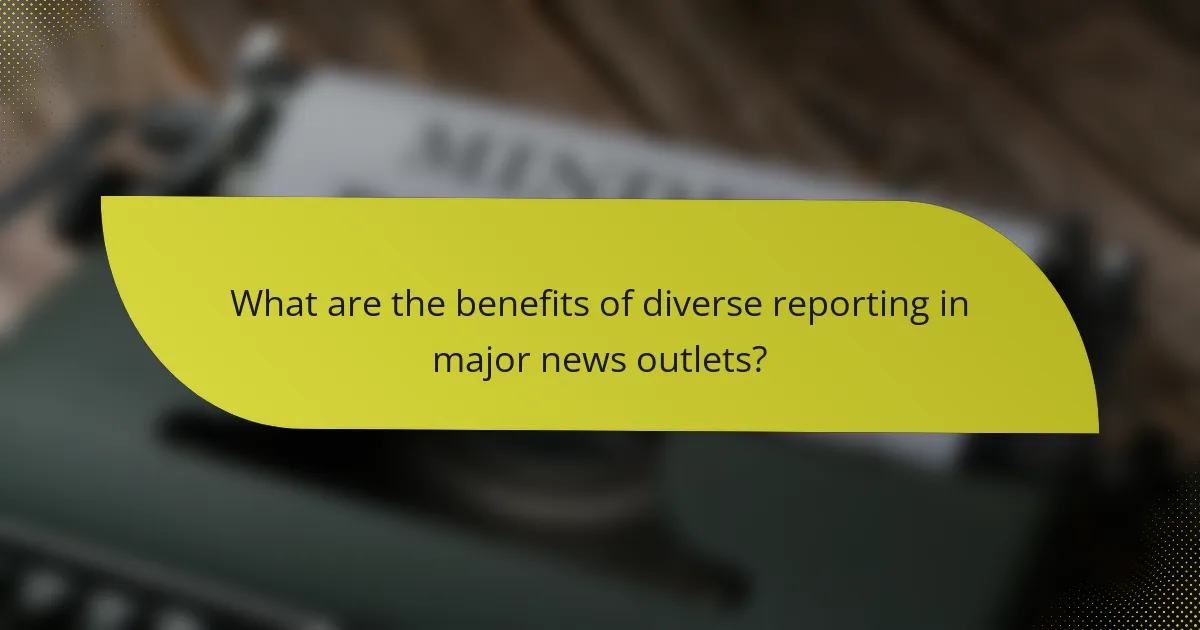
What are the benefits of diverse reporting in major news outlets?
Diverse reporting in major news outlets enhances public understanding of events by presenting multiple perspectives, which leads to a more comprehensive view of issues. This approach not only improves the accuracy of information but also fosters greater engagement and critical thinking among audiences.
Improved accuracy
Diverse reporting contributes to improved accuracy by incorporating various viewpoints and sources, which helps to verify facts and reduce bias. When news outlets include perspectives from different communities or demographics, they are more likely to capture the full scope of an event.
For instance, covering a protest from the viewpoints of both participants and law enforcement can provide a clearer picture of the motivations and consequences involved. This multifaceted approach can help prevent misinformation and enhance the credibility of the news being reported.
Greater audience engagement
Engaging a diverse audience is crucial for news outlets, as it allows them to connect with different segments of the population. When reporting reflects the diversity of society, it resonates more with various groups, encouraging them to participate in discussions and share their experiences.
For example, a news story that highlights the experiences of marginalized communities can prompt those individuals to engage more actively with the media, leading to increased viewership and interaction. This engagement can also drive social media discussions, further amplifying the reach of the news outlet.
Enhanced critical thinking
Diverse reporting encourages audiences to think critically about the information presented to them. By exposing readers to different perspectives, it challenges them to consider multiple sides of an issue, fostering a more nuanced understanding.
For instance, when a news outlet presents contrasting opinions on a policy decision, it invites readers to weigh the arguments and form their own conclusions. This practice not only cultivates informed citizens but also promotes a healthier public discourse.
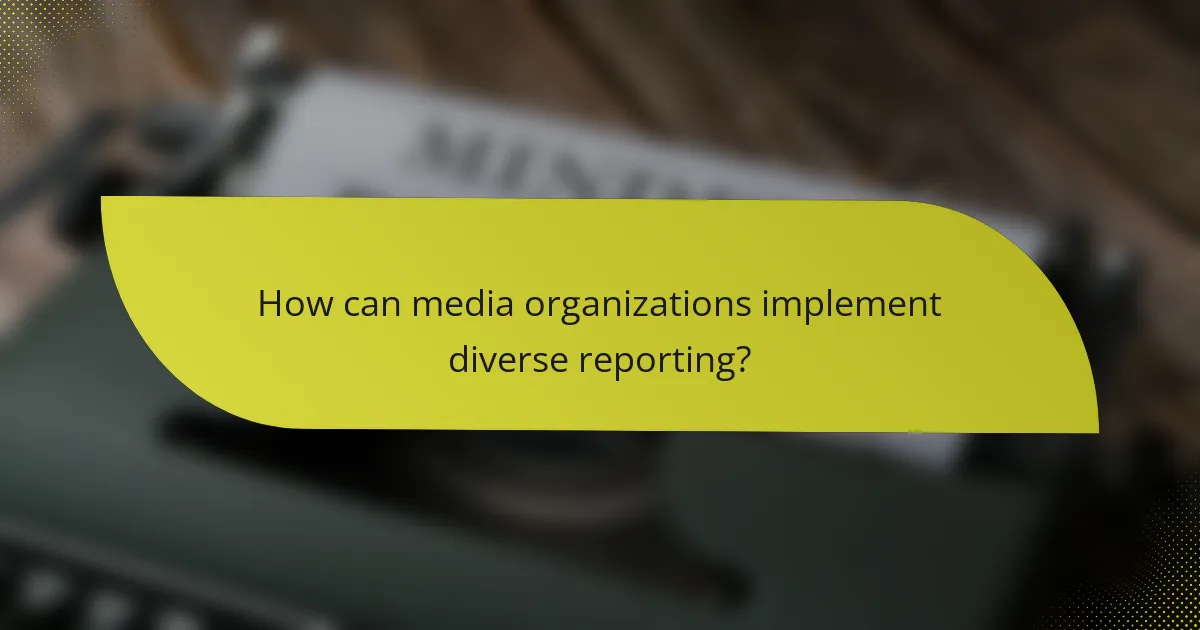
How can media organizations implement diverse reporting?
Media organizations can implement diverse reporting by focusing on varied hiring practices, inclusive editorial policies, and community feedback mechanisms. These strategies help ensure that multiple perspectives are represented, enhancing public understanding of events.
Diverse hiring practices
Diverse hiring practices involve actively seeking candidates from different backgrounds, cultures, and experiences. This can include outreach to underrepresented communities and partnerships with organizations that focus on diversity in media.
Organizations should aim for a workforce that reflects the demographics of the audience they serve. For instance, if a media outlet primarily serves a multicultural urban area, its staff should include voices from those communities to provide authentic representation.
Inclusive editorial policies
Inclusive editorial policies ensure that the content produced reflects a variety of viewpoints and experiences. This can be achieved by establishing guidelines that prioritize diverse sources and perspectives in reporting.
Media organizations should regularly review their editorial content for bias and representation. Implementing training for editors and journalists on cultural competency can also promote a more inclusive approach to news coverage.
Community feedback mechanisms
Community feedback mechanisms allow audiences to share their perspectives and concerns about media coverage. This can include surveys, social media engagement, and public forums where community members can voice their opinions.
By actively seeking feedback, media organizations can identify gaps in their reporting and adjust their strategies accordingly. Establishing a transparent process for addressing community concerns can build trust and improve the quality of reporting.
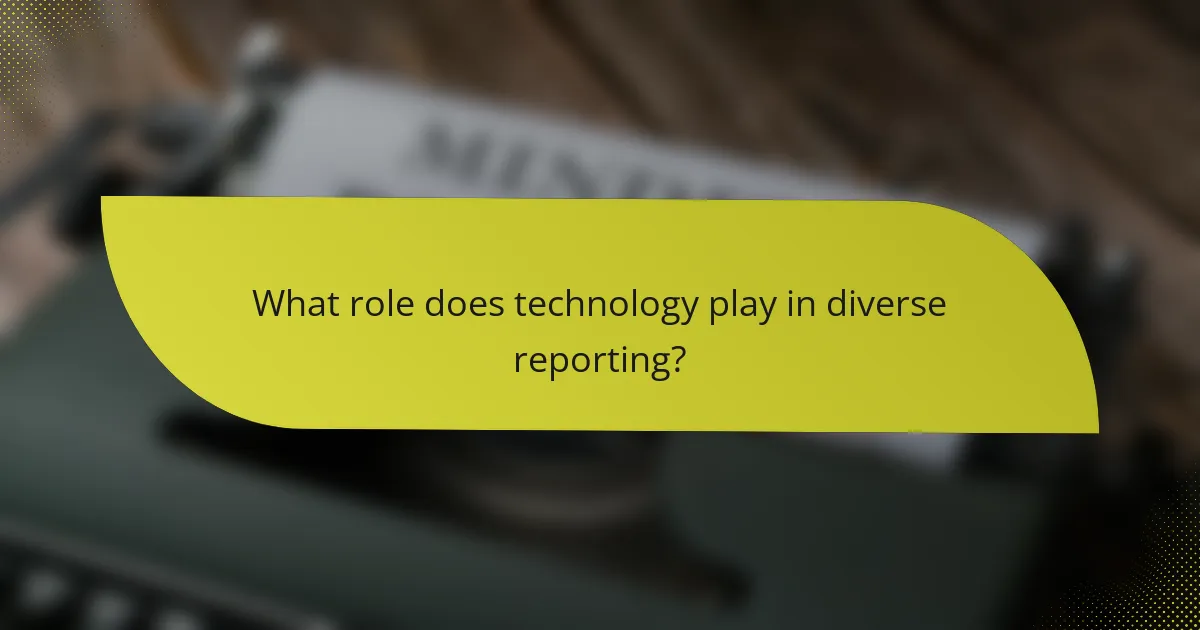
What role does technology play in diverse reporting?
Technology is crucial in diverse reporting as it enhances the ability to gather, analyze, and disseminate information from various perspectives. By leveraging digital tools, reporters can reach broader audiences and present a more comprehensive view of events.
Data analytics for audience insights
Data analytics allows media organizations to understand audience preferences and behaviors, enabling them to tailor content that resonates with diverse groups. By analyzing metrics such as engagement rates and demographic information, reporters can identify which topics are most relevant to their audience.
For example, using tools like Google Analytics or social media insights, news outlets can track which articles generate the most interest and adjust their reporting strategies accordingly. This targeted approach helps ensure that diverse voices are represented in the stories being told.
Social media platforms for outreach
Social media platforms serve as powerful tools for outreach, allowing reporters to share stories widely and engage with various communities. These platforms facilitate real-time interaction, enabling journalists to gather immediate feedback and diverse opinions on current events.
Utilizing platforms like Twitter, Facebook, and Instagram, reporters can connect with underrepresented groups and share their narratives. This engagement not only broadens the audience but also enriches the reporting by incorporating multiple viewpoints.
AI tools for content analysis
AI tools play an essential role in content analysis by helping journalists sift through vast amounts of information quickly. These technologies can identify trends, detect biases, and even suggest diverse sources to include in reporting.
For instance, natural language processing algorithms can analyze news articles for sentiment and tone, ensuring that coverage reflects a balanced perspective. By integrating AI into their workflows, reporters can enhance the quality and diversity of their reporting while saving time on research and analysis.
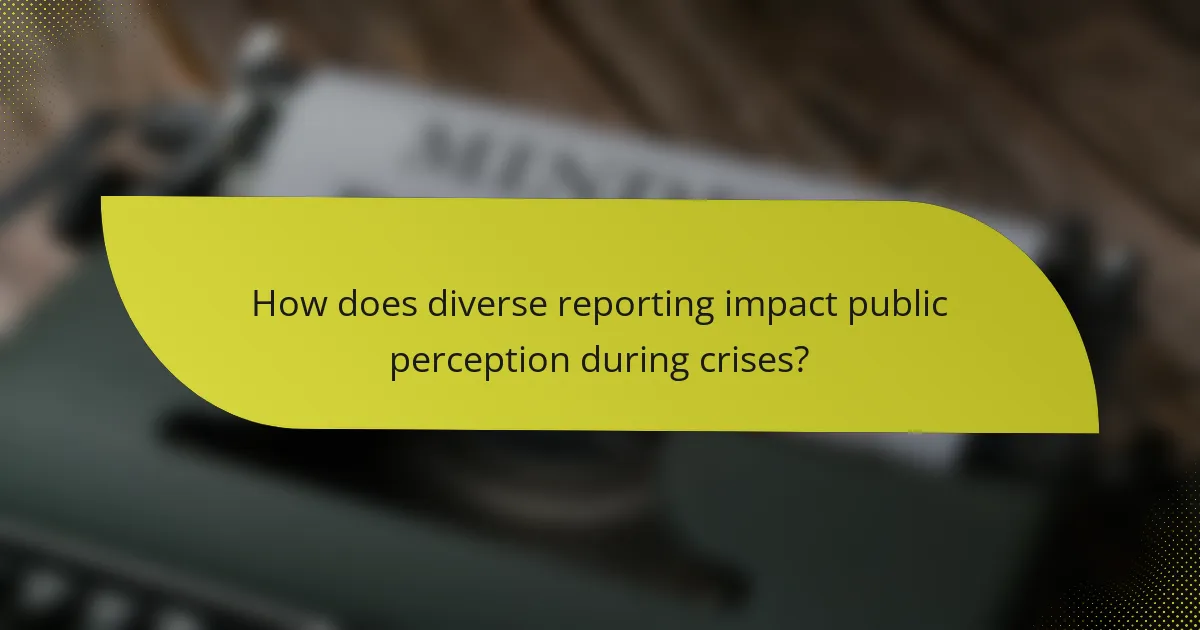
How does diverse reporting impact public perception during crises?
Diverse reporting significantly influences public perception during crises by providing a range of perspectives and information. This variety helps individuals form a more nuanced understanding of events, which can lead to more informed opinions and responses.
Varied narratives shape understanding
Different narratives from various media outlets can highlight distinct aspects of a crisis, allowing the public to grasp the complexity of the situation. For example, one outlet may focus on the humanitarian impact, while another emphasizes political implications. This multifaceted coverage encourages critical thinking and helps audiences avoid oversimplified views.
Additionally, exposure to diverse viewpoints can counteract biases that may arise from a singular narrative, fostering a more balanced understanding of events. Engaging with multiple sources can lead to a more comprehensive picture of the crisis at hand.
Trust in information sources
The credibility of information sources plays a crucial role in shaping public perception. When reporting is diverse, it can enhance trust among audiences, as they see a commitment to presenting multiple sides of a story. This trust is vital during crises, where misinformation can spread rapidly.
To build trust, media outlets should prioritize transparency and accuracy in their reporting. Audiences are more likely to rely on sources that acknowledge their biases and strive for fairness in coverage, especially in high-stakes situations.
Influence on public response
Diverse reporting can significantly influence public response to crises by shaping attitudes and behaviors. When people receive varied information, they are more likely to engage in discussions and take action based on a broader understanding of the situation. For instance, comprehensive coverage of a health crisis can prompt individuals to adopt preventive measures.
Conversely, a lack of diverse reporting may lead to confusion and inaction. It is essential for media outlets to provide clear, varied narratives to empower the public to respond effectively to crises. This can include calls to action, resources for support, and guidance on how to navigate the situation safely.
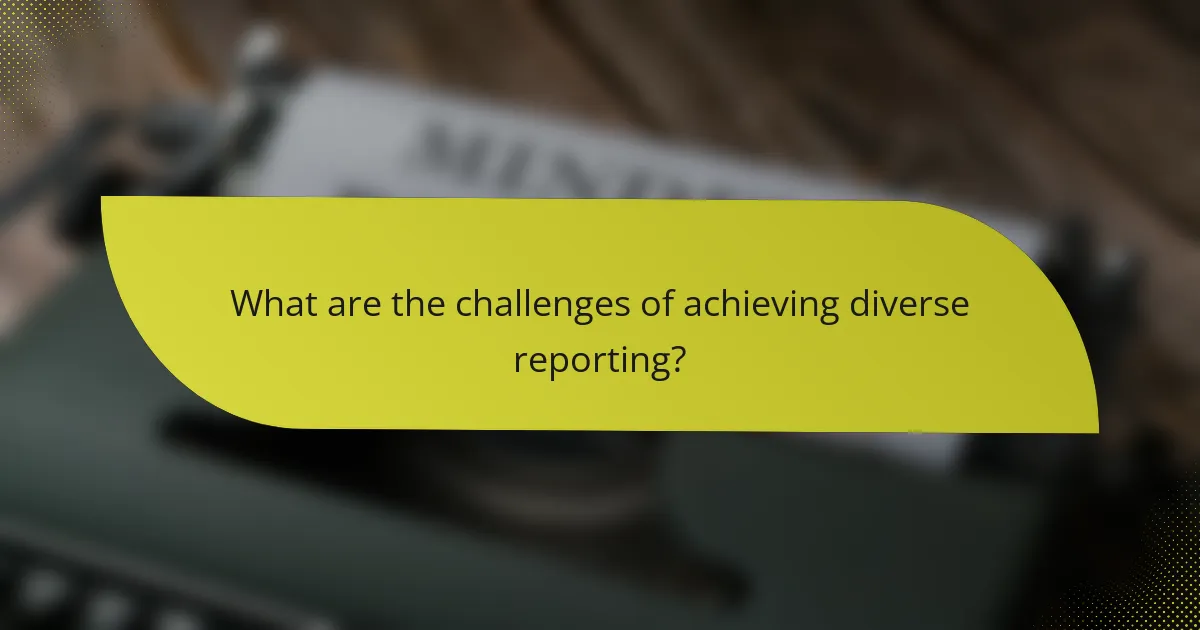
What are the challenges of achieving diverse reporting?
Achieving diverse reporting faces several significant challenges that can hinder the representation of various perspectives in media coverage. These challenges include resource limitations, resistance to change within organizations, and market pressures that prioritize certain narratives over others.
Resource limitations
Many media outlets operate under tight budgets, which can restrict their ability to hire a diverse staff or invest in comprehensive coverage. Limited financial resources often lead to a reliance on a narrow pool of sources, perpetuating a cycle of homogeneity in reporting.
To counteract this, organizations can seek partnerships with community groups or freelance journalists who can provide unique insights. Allocating a portion of the budget specifically for diversity initiatives can also help broaden perspectives in reporting.
Resistance to change
Resistance to change within media organizations can stem from established practices and a reluctance to disrupt the status quo. This inertia may prevent the adoption of new reporting strategies that prioritize diverse voices and viewpoints.
Encouraging an inclusive culture and providing training on the importance of diversity in reporting can help overcome this resistance. Leadership commitment to diversity initiatives is crucial for fostering an environment that embraces change.
Market pressures
Market pressures often dictate the types of stories that are prioritized, with a focus on sensationalism or popular narratives that attract larger audiences. This can marginalize underrepresented voices and limit the diversity of stories covered.
Media outlets can address market pressures by diversifying their content strategies and actively promoting stories that highlight different perspectives. Engaging with audiences to understand their interests can also lead to a more balanced representation of events.
